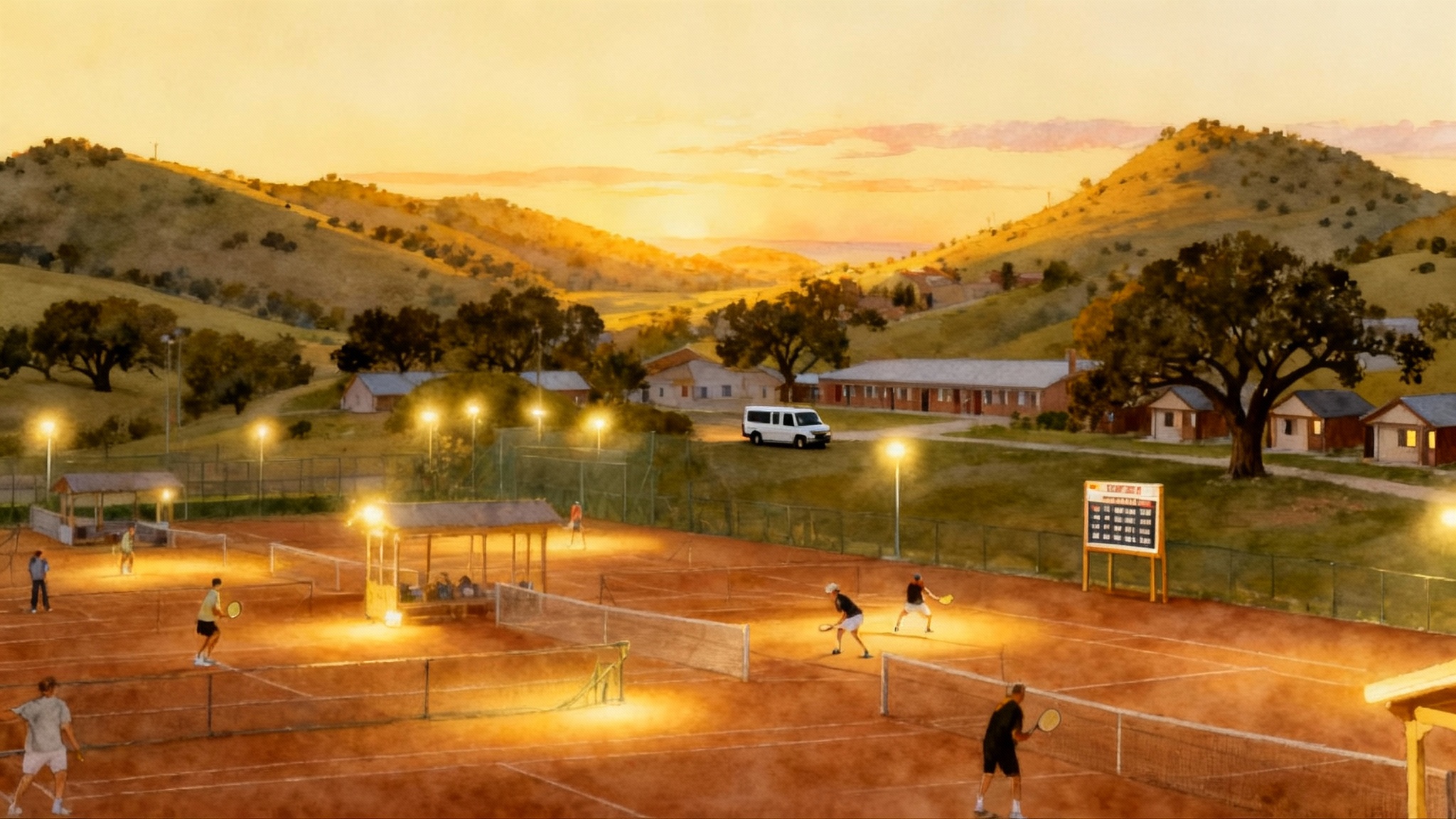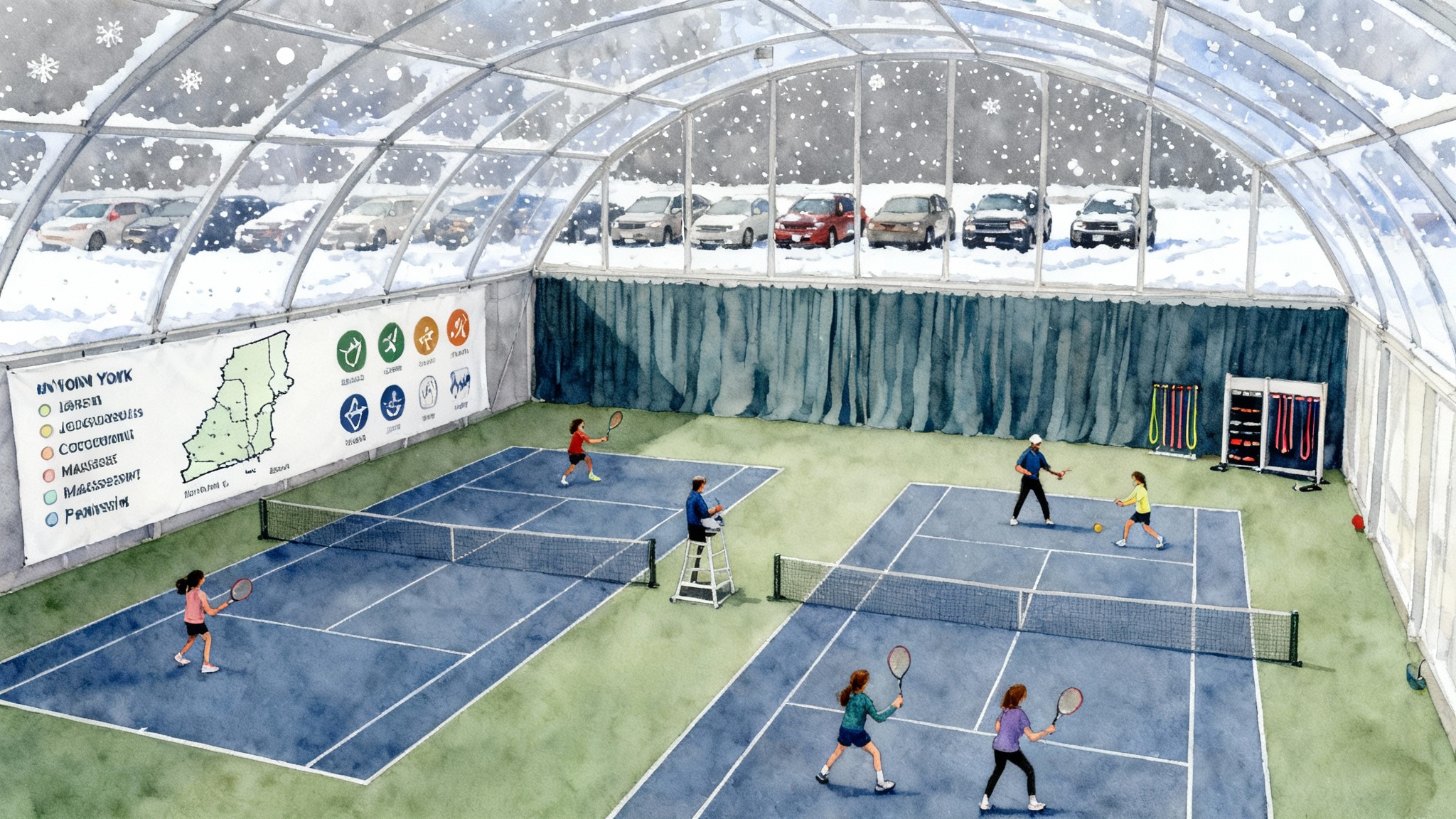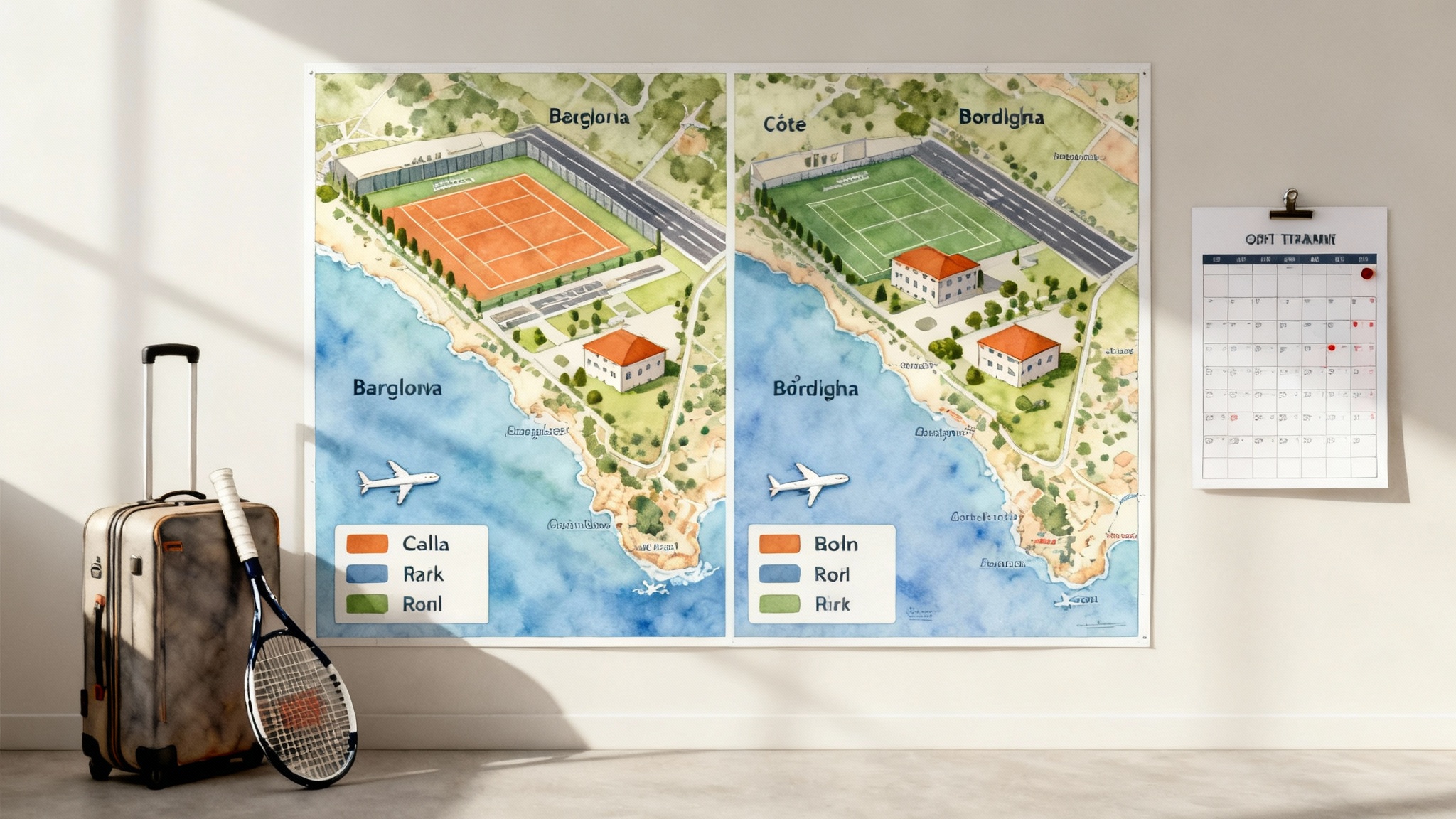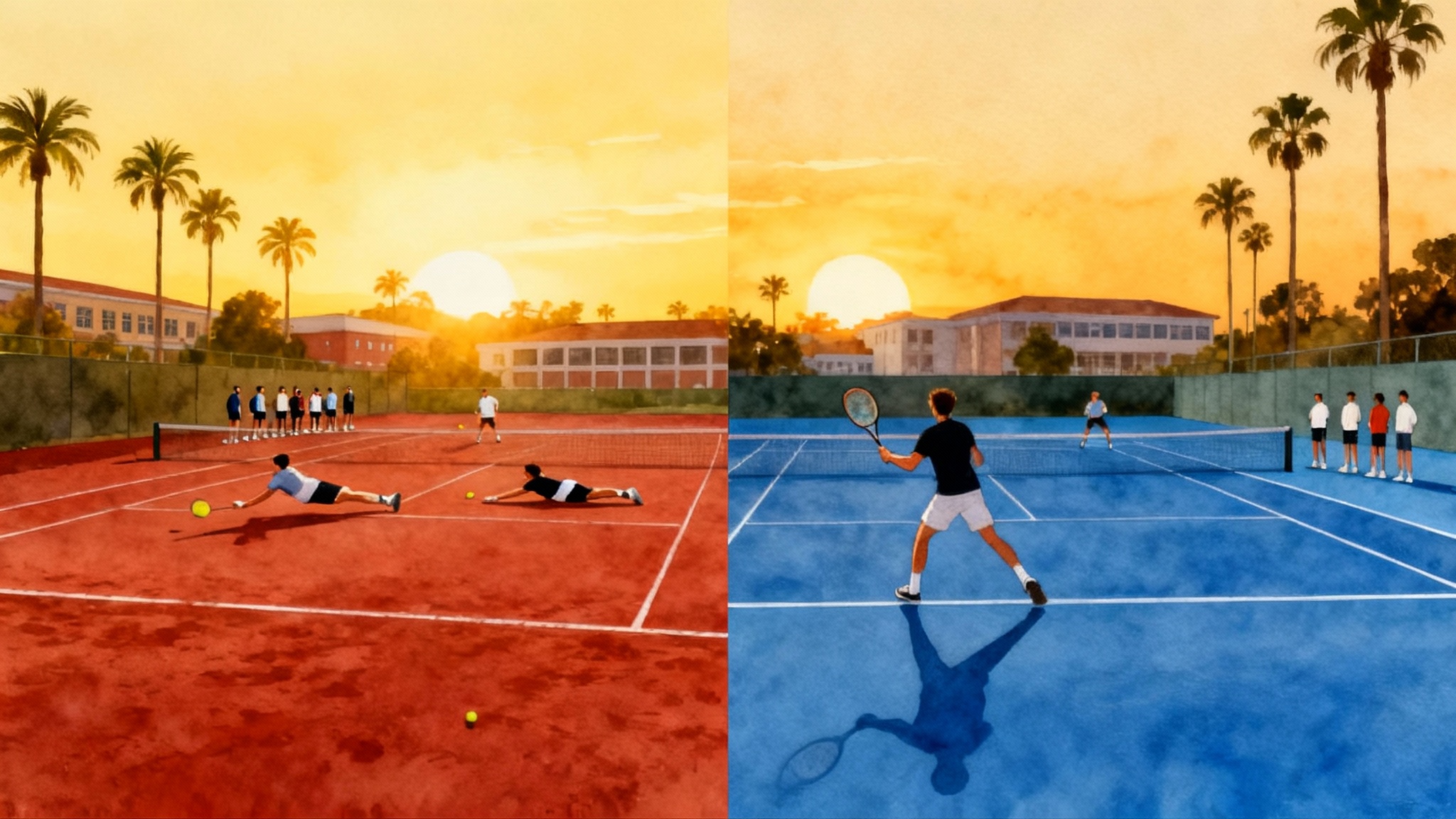Central Europe’s Top Junior Tennis Academies 2025–2026 Guide
A practical, side‑by‑side guide to EMPIRE Trnava, Tennis Europe Academy Prostějov, European Tennis Base Hallein, Ljubicic Tennis Academy Veli Lošinj, and BG Tennis Academy Warsaw. Compare coaching ratios, indoor access, boarding, costs, and pathways.
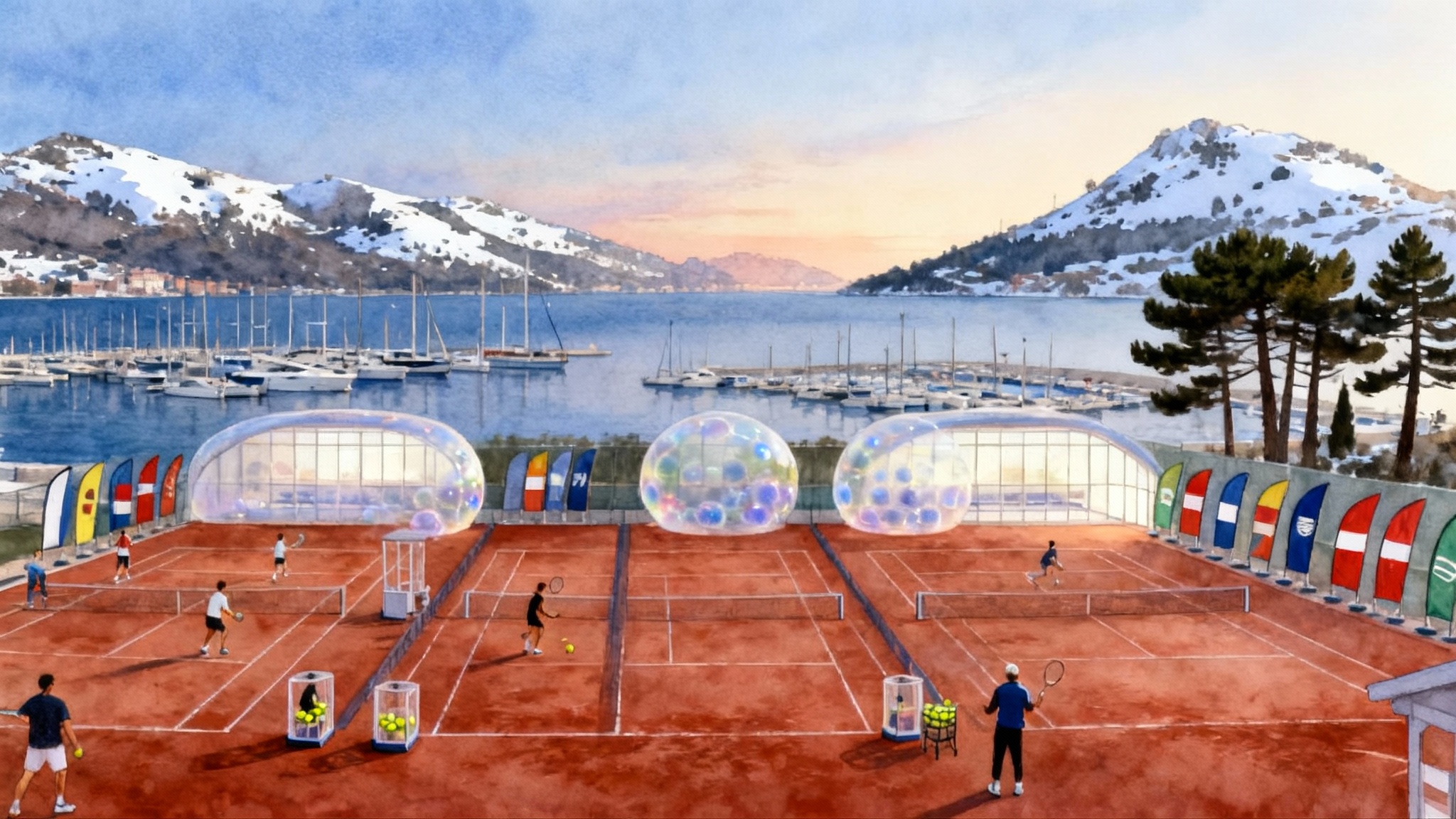
What this guide covers and how to use it
This comparison focuses on five reputable junior programs in Slovakia, Czechia, Austria, Croatia, and Poland. We look at the training surface mix, year-round indoor access, typical coaching ratios, boarding and academics, visas and language, travel and seasonality, program and camp costs, UTR and World Tennis Number integration, and realistic pathways to United States college tennis or the professional tour. Where exact numbers change year to year, we provide ranges and decision criteria so families can compare apples to apples.
All five academies track competitive progress with modern rating systems. If you are new to Universal Tennis Rating, here is a clear primer on what UTR actually measures. World Tennis Number is used widely across Europe; you can review the official WTN explainer.
The five academies at a glance
- EMPIRE Tennis Academy, Trnava, Slovakia
- Tennis Europe Academy at TK Prostějov, Czechia
- European Tennis Base, Hallein, Austria
- Ljubicic Tennis Academy, Veli Lošinj, Croatia
- BG Tennis Academy, Warsaw, Poland
Each runs year-round or near year-round programs, with a clay-first philosophy and access to indoor courts for winter blocks. Coaching is generally delivered in small groups for drilling and in even smaller pods for tactical work. Fitness and injury-prevention are integrated rather than bolted on.
Clay first, indoor always: surface and facility realities
- Slovakia, Czechia, Austria, and Poland share a long indoor season from roughly November through March. Expect bubbles or permanent indoor halls with two to eight courts available to the academy on a schedule. Winter court time is at a premium, so ratios are planned carefully.
- Veli Lošinj in Croatia enjoys a milder climate, so outdoor clay is usable for much of the year. Winter weeks can still require covered or alternative courts, and travel blocks to the mainland are sometimes scheduled for intense indoor blocks when needed.
What it means for your player: if you want heavy clay repetitions with assured winter continuity, the inland academies have the edge. If your player thrives outdoors with sea-level conditions and lots of ball striking under open skies, Lošinj packs a long outdoor season into the calendar.
Coaching ratios and training architecture
- Typical court ratios across these programs sit at 1 coach to 2–4 players for live ball and patterns, and 1 to 1–2 for technical rebuilds. Point-based sets often run 1 to 4–6 with one coach orchestrating constraints. Strength and conditioning blocks are usually 1 to 6–10 depending on the phase.
- A weekly microcycle usually includes three types of on-court work: heavy-ball drilling on clay for length and height, short-court constraint games for timing, and live points to test decision-making. Video is used most on technique days and before or after weekend matches.
How to validate this when you contact an academy: ask for the ratio on each session type, not the average. A 1 to 2 rebuild hour has different value than a 1 to 6 point set. Also ask how often your player will share a basket with older or younger groups, and how the coach balances level gaps during mixed sessions.
Boarding and academics, visas and language
- Boarding and academics: in Trnava, Prostějov, Hallein, and Warsaw you will find structured boarding via partner residences or homestays, and flexible academics via local international schools or accredited online providers. Lošinj often uses hotel-style accommodation during camps and selected long blocks, with online schooling for full-timers. Always confirm the adult-to-student supervision ratio in housing, quiet study hours, and how missed classes are supported during travel weeks.
- Visas: Slovakia, Czechia, Austria, Croatia, and Poland are in the Schengen Area. United States and many other non-European Union citizens can enter for up to 90 days within any 180-day window for short camps. For stays longer than 90 days, families should plan a student or long-stay visa well in advance through the host country. Start the process at least 12–16 weeks ahead of the intended start.
- Language: English is widely used in all five academies. Coaches can often switch to Slovak, Czech, German, Croatian, or Polish as needed. Schools and homestays typically operate in English or offer bilingual support.
Travel and seasonality
- Trnava, Slovakia: Bratislava Airport is closest; Vienna International is a common hub with frequent connections and about an hour’s drive. Winter is cold, so expect an indoor heavy block from November to March.
- Prostějov, Czechia: Prague and Vienna are the big hubs; Brno works for regional flights. Winters require reliable indoor time; the club environment is very tournament-savvy.
- Hallein, Austria: fly into Salzburg, with Munich as a backup. Alpine winters mean disciplined indoor scheduling. Summer offers a great mix of outdoor clay and altitude-friendly fitness work nearby.
- Veli Lošinj, Croatia: Rijeka is the nearest airport, with Pula and Zagreb as alternatives. Ferries and island roads shape transfers, so plan arrival and departure days carefully. The shoulder seasons of March to May and September to November can be ideal for volume on clay with mild temperatures.
- Warsaw, Poland: Chopin Airport and Modlin handle most arrivals. Winters are indoor heavy; summers offer dense tournament calendars across Poland and neighboring countries.
Program and camp costs you should expect in 2025–2026
- Weekly camps, training only: roughly 600 to 1,200 euros depending on indoor court costs and included fitness. Add 300 to 700 euros for boarding and meals.
- Full-time monthly programs, training only: roughly 1,500 to 3,000 euros. With boarding and meals, 2,500 to 4,500 euros. Schooling is extra if you choose a brick-and-mortar option.
- Tournament travel: budget 150 to 250 euros per day per player when sharing travel with teammates and staff on regional trips. National or international events with flights can push higher.
Use these numbers to frame value, then request a written quote that lists: number of on-court hours, strength and conditioning hours, video, physio, match coaching, tournament days, housing, meals, airport transfers, and school support.
UTR and WTN integration, and what that means for recruiting
- All five academies log match play regularly in UTR-counting sessions or sanctioned events. Consistent wins against rated opponents at similar UTR move the needle faster than blowouts against weak fields. Knowing how UTR weights score margin will help families set smart goals; review the primer above for specifics.
- World Tennis Number is used by clubs and national federations across Central Europe, which makes it practical for scheduling competitive weekends without excessive travel. Recruiters in the United States now look at both UTR and WTN to triangulate true level, especially for younger players whose ratings are still volatile.
Practical use: lock in two rating touchpoints per week during training blocks, then schedule tournament bursts for three consecutive weekends each month. That rhythm tends to stabilize ratings while leaving room for technical work. For families mapping the next steps, our college recruiting roadmap for 2025 shows how to package results for coaches.
Academy-by-academy notes
EMPIRE Tennis Academy, Trnava, Slovakia
- Identity: clay-first academy environment with a track record of pushing players into dense regional competition calendars. Good for players who need structure and clear weekly cycles.
- Indoor plan: winter training runs on booked hall time and bubbles, with predictable morning and afternoon slots. Expect efficient use of baskets and set-play constraints to maximize limited indoor hours.
- Coaching rhythm: technical rebuilds in pods of 1 to 2, live point work in 1 to 4. Fitness emphasizes repeat sprint ability, footwork on clay, and shoulder health.
- Academics and boarding: partner residences and homestays are common, with supervised study. Online schooling is the default for full-time internationals.
- Pathways: strong entry point to Central European Tennis Europe and International Tennis Federation junior calendars. Logical springboard to United States college for players in the UTR 8 to 11 range by age 16, with a smaller pipeline pushing beyond that to pro events.
Learn more in our EMPIRE Tennis Academy in Trnava profile.
Best for: disciplined grinders and counterpunchers who benefit from volume on slow courts, and late-physical maturers who need time to consolidate patterns.
Tennis Europe Academy at TK Prostějov, Czechia
- Identity: tournament-savvy culture inside a major Czech club. Players learn how to win matches on consecutive days, not just hit pretty balls.
- Indoor plan: deep winter access to bubbles or halls, with club ladder matches that count toward ratings and sharpen competitive habits.
- Coaching rhythm: tactical periodization is a strength. Expect 2 to 3 focused themes per week, for example second-serve pressure, redirection from the backhand corner, or first-ball plus-one plays.
- Academics and boarding: structured boarding via club partners and nearby residences; a stable option for multi-month stays.
- Pathways: frequent exposure to strong Czech and Slovak draws builds resilience. With the right results, players can step into fifteen thousand dollar and twenty-five thousand dollar pro qualifying events while still juniors.
Best for: match-tough shotmakers who want a club that lives and breathes competition, and players who crave detail on patterns and scouting.
European Tennis Base, Hallein, Austria
- Identity: technique-first program with Austrian attention to movement quality. The environment rewards players who enjoy meticulous work on the small things that unlock big gains.
- Indoor plan: reliable winter hall time around Salzburg, plus outdoor clay blocks in the warmer months. Fitness benefits from nearby hills and trails for stamina and elastic strength.
- Coaching rhythm: clean swing shapes, efficient spacing, and repeatable contact points. Video is common during the build phase. Ratios for rebuilds skew small, often 1 to 1–2, which suits technical overhauls.
- Academics and boarding: partner housing with quiet study windows and easy access to Salzburg schools or online programs.
- Pathways: particularly effective for players who need a technical reset before launching into heavier tournament schedules.
Best for: late-teens who must fix inefficiencies to unlock power, and younger athletes who want a fundamentals-heavy start that scales.
Ljubicic Tennis Academy, Veli Lošinj, Croatia
- Identity: Mediterranean training block with a pro-inspired ethos. The location and climate allow long outdoor sequences and a positive, high-ball-volume feel.
- Indoor plan: outdoor first. Winter requires flexible planning and occasional covered sessions. The academy leverages weather windows to sustain volume and uses travel blocks when a pure indoor phase is essential.
- Coaching rhythm: pattern play built around first-strike tennis and proactive footwork. Fitness includes heat management, recovery in warm conditions, and shoulder care.
- Academics and boarding: boarding often aligns with hotel-style stays during camps, with online schooling for longer stints.
- Pathways: ideal for spring and autumn intensives leading into tournament bursts across Croatia, Italy, and Slovenia.
See the Ljubicic Tennis Academy on Losinj profile.
Best for: aggressive baseliners who love outdoor rhythm, and confident all-courters who want to sharpen first-strike patterns in real weather.
BG Tennis Academy, Warsaw, Poland
- Identity: big-city academy with practical access to dense Polish tournament calendars and strong winter indoor culture.
- Indoor plan: bubbles and halls keep training on schedule from November to March. Expect crisp, time-efficient sessions.
- Coaching rhythm: balanced technical and tactical blocks, with a strong emphasis on serve plus one and return plus one patterns.
- Academics and boarding: homestays and partner residences are typical; online schooling and international programs fit around travel.
- Pathways: excellent for building a match log quickly. Polish national events and regional trips feed consistent rating gains.
Best for: organized competitors who thrive in a city rhythm, and players who want many match opportunities within short travel distances.
Sample weekly schedules
Below are templates you can ask any academy to match or modify. Use them to check if the plan is realistic for your player and to expose where bottlenecks might occur.
Full-time boarding week, indoor season
- Monday
- 07:00 mobility and activation
- 08:00 on-court technical pod, 1 to 2, forehand contact work
- 10:00 school block
- 14:00 strength, lower body force and shoulder care
- 16:00 live ball, 1 to 4, heavy crosscourt patterns
- 18:00 study hall
- Tuesday
- 07:00 aerobic flush
- 08:00 returns and first two shots, 1 to 3
- 10:00 school block
- 14:00 sprint mechanics and agility
- 16:00 match sets, 1 to 4–6, scores recorded for rating
- Wednesday
- 08:00 video and technical pod, 1 to 1–2, serve rhythm
- 10:00 school block
- 15:00 strength, upper body pull and trunk rotation
- 17:00 constraint games to targets
- Thursday
- 07:00 mobility
- 08:00 situational points, 30–30 starts
- 10:00 school block
- 14:00 aerobic capacity or bike
- 16:00 sets, 1 to 4–6, rating logged
- Friday
- 08:00 tactical rehearsal, opponent patterns
- 10:00 school block
- 14:00 speed, jumps, and reaction
- 16:00 touch and feel, short court
- Saturday
- Tournament play or in-house ladder, coach courtside
- Sunday
- Off or light recovery, stretch, and review
Ratios summary in this template: technical pods 1 to 1–2, live ball 1 to 4, sets 1 to 4–6, fitness 1 to 6–10.
One-week camp, mixed indoor and outdoor
- Day 1: baseline assessment, movement screen, serve video
- Day 2: forehand height control on clay, return practice, mixed games
- Day 3: backhand direction changes, overheads and transition
- Day 4: first-strike patterns, compete in timed sets
- Day 5: pattern consolidation, serve plus one, return plus one
- Day 6: match day with coaching feedback, rating entries
- Day 7: recovery hit, debrief, take-home plan
Best-fit profiles by player type
- The meticulous rebuilder: needs a technique reset to stop leaking errors under pressure. Best fit: European Tennis Base in Hallein, with small technical pods and high video use.
- The match-hardened tactician: learns fastest from frequent competition and club culture. Best fit: Tennis Europe Academy at TK Prostějov, with ladder play and tournament flow.
- The volume-loving aggressor: wants long outdoor sessions and first-strike refinement. Best fit: Ljubicic Tennis Academy in Veli Lošinj, with long outdoor windows.
- The structured grinder: thrives on clay rhythm and consistent winter scheduling. Best fit: EMPIRE Tennis Academy in Trnava, with efficient indoor blocks.
- The organized commuter: wants many matches within a city footprint and strong winter indoor access. Best fit: BG Tennis Academy in Warsaw.
How to choose using three concrete filters
- Training architecture fit
- Ask for the session-type ratios, not just the headline ratio. Confirm two weekly rating touchpoints. Request a real sample week similar to the templates above.
- Academic and housing fit
- For full-timers, get a written plan for school hours, exam weeks, and proctoring. Verify adult supervision ratios in housing and curfew times. Families of younger players should ask how the academy handles illness, injuries, and homesickness.
- Competition logistics
- Map likely tournaments for the next 12 weeks, travel times, and budget per event. Ask whether the coach will be courtside and how feedback is delivered into the next week’s plan.
Common pitfalls and how to avoid them
- Chasing a name without a plan: a famous academy does not fix misaligned ratios or schedules. Always match the microcycle to the player’s needs.
- Under-budgeting indoor season costs: winter court fees raise prices. Secure exact winter pricing in writing.
- Ignoring recovery: clay volume plus indoor intensity can overload shoulders and calves. Non-negotiables include shoulder prehab three times a week and calf complex strength twice a week.
Bottom line for 2025–2026
If your player needs clay repetitions with reliable winter continuity and a structured academic setup, look first at Trnava, Prostějov, Hallein, and Warsaw. If your player blooms outdoors and gains confidence from long, sunny hitting windows, schedule a block on Lošinj and pair it with mainland indoor weeks in winter.
Pick the academy that best fits your player’s phase, not the one with the flashiest brochure. Confirm ratios by session type, secure indoor access on a written schedule, lock in two rating touchpoints each week, and build a 12-week tournament map. Do those four things and your 2025–2026 season will move from hopeful to intentional.
